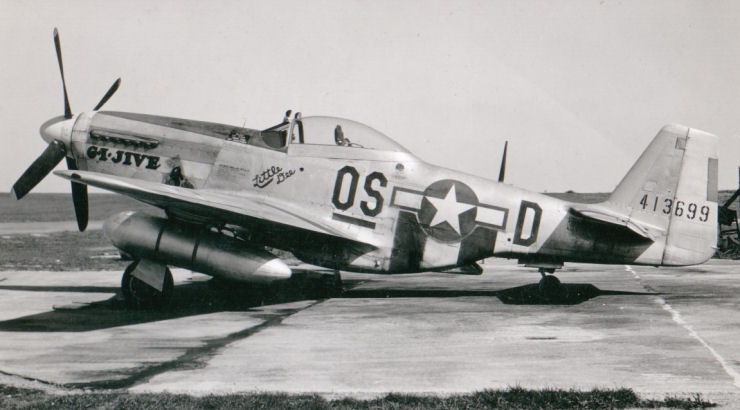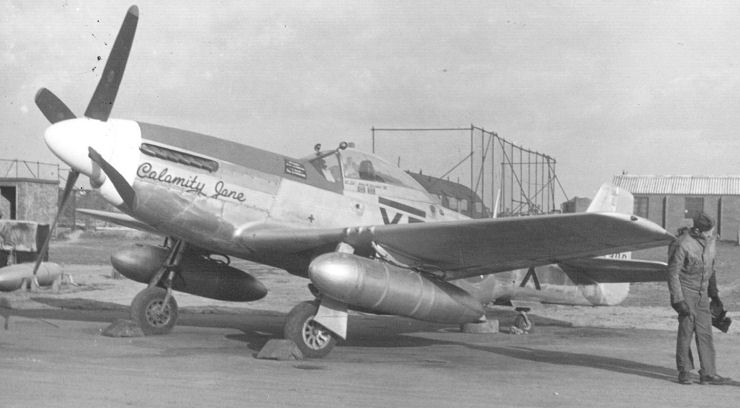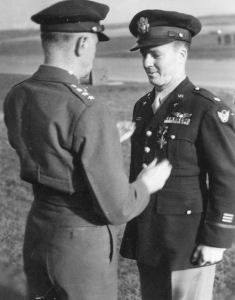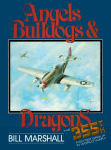|
The History of the Scouting Force has been done very well by Dick Atkins in his book “Fighting Scouts of the Eighth Air Force 1944-1945”. The author will not devote the level of detail Atkins provided in this book but has crafted a brief history of how this fine organization came to life and how the Progenitor Scout Force (Experimental) and the derivative Second Scout Force came to be part of the Steeple Morden family supported by the 355th Fighter Group. The story of the Scout Force starts at 8th AF HQ in the fall of 1943, and was primarily the brainchild of Colonel Budd Peaslee, Group Commander of the 384th Bomb Group. Peaslee had a reputation for being tough and smart with a well deserved reputation for thinking ‘out of the box’. He was extremely sensitive to the fact that German fighters and anti aircraft artillery were only part of the forces arrayed against the 8th AF bombing campaigns to destroy German industry. Weather also played havoc with plans and efficiency. The classic decision for a mission commander was whether to attempt to penetrate heavy weather blocking target routes because of unknown future conditions, as well as visibility over the target, particularly French targets. In the case of targets over occupied France, the bombers could not even salvo bomb loads unless clearly not a hazard to French people below – an impossible decision if clouds obscured the ground. Nor were conditions over alternate targets guaranteed to enable mission success. Equally important was the consequences of sending hundreds of crews in heavily loaded bombers into the heart of thunderstorms with high turbulence and terrible icing conditions. Mistakes made with weather decisions in theory and practice caused loss of many lives and aircraft. Peaslee reasoned that a fast fighter with range such as a Lockheed P-38 or P-51 Mustang or Dehaviland Mosquitos would enable a ‘bomber operations knowledgeable” pilot or unit to range far ahead of a bomber strike and report on target weather conditions as well as route weather so that contingencies could be made in advance to alter the tactics. The P-47 did not have adequate range to perform such missions at the time and would not for at least another year. The P-38 had the range and the speed but already the 8th AF Commander, General Doolittle, was seriously thinking of replacing the P-38 with the Mustang because of the high altitude issues experienced by the Allison engines. The Mosquito was a good potential vehicle because it could carry a skilled navigator. The Mustang was an even better choice but at that time the USAAF had only a few Mosquitos, and virtually no Mustangs in late 1943. Additionally the pilot of the Mustang had to be not only bomber operations knowledgeable pilot but also a skilled navigator. The first challenge was to sell the concept but it was also necessary to get the priority to acquire critical resources like Mustangs or Mosquitos for the role as well as a Table of Organization and Equipment (TO&E) to support the aircraft and crews. He was working through the challenges at a time when every bomb group was clamoring for more fighter escort and the 8th AF Fighter Command was growing from 5 Groups to 15 Fighter Groups. Resources like Mustangs were at a premium, priority wise. The second essential component of the equation was recruiting and training Scouts with good navigational skills and expert instrument pilot was essential to probe weather conditions. He reasoned, correctly, that bomber pilots finishing their tours with B-17s and B-24s would leap at the chance to fly fighters. The complimentary challenge was that changing from crew served aircraft to less forgiving, high performance, fighters such as Mustangs was not an easy transition. Initially an attempt was made to use pilots from existing fighter groups to perform the same function. The result was largely unsatisfactory because the average fighter pilot did not fully understand the operational problems of bombardment groups in the conduct of their (bomber) missions, nor was he particularly skilled at all weather flying or navigation as his heavy bomber counterpart. In late March, 1944 Peaslee lobbied first with his boss Colonel Howard Turner, then Commander of the 40th Bomb Wing to get initial approval of the concept, then took his case to 1st Air Division Commander General Robert Williams. Following approval at 1st AD, he presented the concept in May to General Doolitle, General Pat Partridge and General Curtis LeMay – all heartily endorsing the idea and directed him to formalize the plans. The key boundary conditions Doolittle insisted on was, a.) Prove the concept with a small experimental force and, b.) that it become part of an existing Organization with an existing Table of Organization and Equipment. The latter stipulation meant that it would be difficult to promote from within as the pilots would be on ‘detached service’ from their parent organization and not very visible promotion wise. The benefit was very fast start to Operations as the infrastructure of the ‘host’ Fighter Group would already be in place. Peaslee recruited eight bomber pilots from various 1st Air Division Lead Crews, plus HQ staff personnel such as Force Navigators, an Intelligence Officer, and both a Deputy Commander and Operations Officer to assist in planning the missions. The plan also required both fighter pilots and logistics support from the parent Fighter Group TO&E. Just after D-Day, the 355th FG, commanded by Colonel William (Wild Bill) Cummings was chosen as the base of operations, while closely coordinating with 1st AD HQ the details of each Scouting mission. The lead officers were at Steeple Morden (F-122) on June 20th and started drawing volunteer fighter pilots from each squadron in the 355th. in early July, 1944. The Scout Force (Experimental) was formed as a fourth Squadron of the 355th Fighter Group. The approach to form the new squadron was for each existing Squadron (354th, 357th and 358th FS) to create a “E” Flight of six ships with Mustangs and Crew Chiefs and Armorers drawn from each squadron. The initial aircraft supplied to these E flights were the brand new P-51D-5’s just arriving into the Group. The Scout ships were given the same markings as the rest of the 355th FG Squadrons their “E” Flight was assigned to - with one distinction – the squadron codes (WR, OS and YF) were differentiated by adding a horizontal ‘bar’ under the code (e.g WR instead of WR to denote Scout Force versus 354th FS). Other than that one difference, each ship had a white spinner, white nose band and white rudder plus invasion stripes on bottom of wing and fuselage.  Scouting Force (Exp) P-51D G I Jive, Steeple Morden July 1944. This aircraft was attached to E Flight, 357th FS/355th FG (Cox)
Scouting Force (Exp) P-51D G I Jive, Steeple Morden July 1944. This aircraft was attached to E Flight, 357th FS/355th FG (Cox)The fighter pilots assigned to the Scouting Force (Experimental) were initially only 355thFG pilots but other volunteer pilots from the rest of the 65th Fighter Wing soon were integrated into the Scouts. The role of the fighter pilots was twofold. The first and primary role was flying wing as protection for the lead Scout pilot. The second role was to perform instructional duties to assist the ex-B-24 and B-17 drivers to transition “smoothly” in the art of flying the spirited Mustang. The lead pilots were volunteers from the Second Bomb Division who had completed their tours as B-24 drivers and wanted to fly Mustangs. Over the next several months a Standard Operating Procedure for training newly accepted bomber pilots was first a qualification interview usually with either the 355th Fighter Group Deputy or Operations Officer, then a couple of check rides in an AT-6. Following the check ride, the pilot went through the standard 8th AF pre-combat indoctrination training that ALL fighter pilots received in theatre. Usually 20 hours in a Mustang was deemed sufficient transition training to then place the pilot on combat operations for the Scout Force. The early training of bomber pilots was not without mishap. The first pilot was killed on July 26. Lt Robert Bennett (ex 475 BG) made a gunnery pass behind a Tow Target B-26 and spun out near the Thames River. Lt Colonel Gerald Price, Peaslee’s Deputy, was killed when his Mustang lost a wing in Fighter Training on August 23rd near Diddington. Following the accident, Lt Colonel Al Brooks joined Peasless as his Deputy to replace Price. The next two were killed in a training accident in an AT-6 on September 1st when Lt Teleschor Lojowski and Lt. Charles Wright were killed when their ship dug a wing on a steep final after an engine failure near Grafton Underwood. Lt. Bertleson was next when he lost control of his AT-6 at Steeple Morden Even with the skill and flight time of the ex bomber pilots, the Scout Force (s) would continue to experience a pretty high percentage of losses in accidents for the duration of the war. Later, when the 2nd SF was in full operation at Steeple Morden, each bomber pilot desiring to volunteer as a 2nd Scout had to pass an interview with the 355th FG Deputy Group Commander, Lt Colonel Bert Marshall, before permission was given. The Scout Force’s first mission was Munich was on July 16, 1944 The Scout Force (Experimental) lost their first and only pilot in aerial combat with the Luftwaffe on August 1, 1944. A flight of Scouts was returning from a mission when they engaged German fighters in the La Loupe area NE Paris and Lt. Vince Dressendorfer was KIA by Obstltn Ihlefeld of Stab/JG1, one of the top Luftwaffe aces in the West. In a separate engagement Dick Dillon, a 358FS pilot attached to the Scouts, shot down a Me 109. Near the end of the Scout Force (Experimental) trial phase, Lt Colonel John Brooks, III, was assigned to observe the 1st Division Operations in August, 1944. Brooks brought a wealth of experience in bomber operations including leading the 389th BG on the August 1st, 1943 low level attack on Ploesti, for which he won the Silver Star. Brooks was another leader thinking along the same lines as Budd Peaslee regarding improving weather/target related intelligence and jumped at the chance to lead Scouts. He came to Steeple Morden in August, 1944. As an ‘observer’ John Brooks flew several missions. His first was truly memorable. On 16 August Scout Force (Experimental) flew to Leipzig and on the way back John Brooks noticed that six Me 109’s were sneaking up on his number four who had trailed the formation. He ordered the other two members to proceed home and returned to engage the 109s’ After several tense minutes of tight turns in a Lufberry, the 109’s broke off and Brooks returned to Steeple Morden without having fired a shot in the engagement. Brooks credited the result with the very fine advice he received from a 355th ace, Captain William Hovde. “Colonel”, he said, “if you get into a turning fight with one of those clowns just haul it over and pull that stick into your gut”. On 17 August, the 8thAF HQ Operations approved the concept and designated one Fighter Group from each of the 65th , 66th and 67th Fighter Wing to ‘host’ a separate Scout Force, forming a fourth squadron just like the 355th FG. In this way the Division Scout Forces for the 1st, 2nd and 3rd Divisions were created. The new Scouts were officially 1st Scout Force with the 364th FG at Honington, the 2nd SF would be part of the 355th FG at Steeple Morden, and the 3rd SF went to 55th FG at Wormingford. The Scout Force (Experimental) formed the nucleus of the new Division Scout Forces. Peaslee became 1st SF CO and took Allison Brooks, his Deputy after Gerald Price was killed, plus several pilots including Buckles, Burdge, Cox, and McCrory. He also took Harold Strain for Operations Support. Even though the official orders stipulated transfer of personnel on 21 September, Peaslee had his team flying combat operations two days before that date. In most cases, the Mustangs and Crew Chief went with the pilot transferring from Experimental Scout Force to either 1SF, 2SF or 3SF, became part of the TO&E of the new organization. Major Vince Masters was named Commander of 3rd SF. Following completion of Fighter transition training at Goxhill in August he formed his own team. Lt Colonel John Brooks, III was named Commanding Officer of the 2nd SF. After his appointment as Commander, Lieutenant Colonel Brooks began building his team. He selected Major Frank Elliot as his Deputy and recruited several other bomber pilots (Whitlow, Ziegler, Counselman, Bertleson, Weber, Edmonson, and Moore) to act as lead pilots. The 355th Fighter Group supplied several fighter pilots, including Sumner Williams, Richard Dillon, Floyd Taylor and James Kilmer to the new 2nd Scout Force. All of these had already served with the Experimental Scouts. Other groups in the Wing also supplied experienced fighter pilots to act as escorts to the lead bomber pilots in their new Mustangs. Several notable pilots included Bill Whalen and George Ceglarski, recent transfers from 4FG to the 355th in a ‘cross breeding’ experiment hosted by Lt Colonel Claiborne Kinnard, Jr and Colonel Bill Cummings. Whalen soon volunteered to the 2SF in November and Ceglarski joined him. These two would become the only Scout Force aces, Whalen getting six air/two ground, while Ceglarski would get one air and five ground. scores. Whalen’s first victory was with the 4th FG before he transferred to the 355th in September. Major Elliot had the distinction of having more flying time than anybody on the base and Captain Bob Whitlow, ex-West Point tackle and classmate of Billy Hovde, was probably the largest Mustang pilot in the ETO with the possible exception of 20th FG ace Ernest Fiebelkorn. The 355th Mustangs assigned to the 2nd Scout Force had a black horizontal bar above the WR, OS or YF squadron identification letters of the 354th, the 357th and the 358th Squadrons, respectively, whereas the Experimental Scouts had black bars under the squadron code. In addition the anti glare panel was painted horizontally from cockpit to cowl ring at the top of the panel surrounding the exhaust stacks.  All the bomber pilots flew about 20 hours in the 355thFG AT-6 in order to transition to the P-51. After about 15 to 25 hours in the Mustang, including formation and further transition training, the bomber pilots were usually accepted as competent to fly the Mustang and ready for their operations. During training however, Lieutenant Jim Bertleson was killed in a flying accident when his AT -6 spun in near Steeple Morden on September 11, 1944. Captain Ziegler had a mid-air collision and suffered a broken arm. After a long stay in the hospital he was sent home. The first mission for the new Scout Force was to Hamm on September 26, 1944. While the primary function of the Scouts was to report weather conditions, they also provided valuable service in other ways. Several times during the war the Second Scout Force also reported large concentrations of German fighters to the 355th. Nor did they shy away from German fighters even when greatly outnumbered. On November 26, 1944 the 2nd SF took 12 ships to scout Misburg and Bielefeld. Four ships went down to check out Bielefeld while the remaining eight stayed out in front of the Misburg force. Near Hannover approximately 200+ FW-190s and escorting Me 109s, in two separate gaggles, were observed approaching the bombers. At the time of the attack, the three B-24 groups that the 355th and 339th FG were chartered to escort were strung out on a 40 mile line due to a navigation error and impossible to cover with even two Fighter groups. The 339th was trailing and closer to Dummer Lake. The Luftwaffe Controller detected the lack of coverage and skillfully orchestrated the attack in between the 355th and 339th FG. The large German force split into several smaller forces of 50 to 75 fighters and attacked in waves at the rear of the 339th. The 491st BG immediately lost 15 B-24’s to heavily armed JG301 Fw 190 A-8s from a ‘company front’ attack from the rear before the 354FS and 357FS intervened to drive them off in a major dogfight ranging to the deck. The 339th picked up two more large enemy forces further west and the sky in the Hannover-Gardlingen-Dummer Lake region was full of fighters and bombers in various states of distress. Shortly afterwards another force of JG 301 fighters attacked the 445th BG strung out behind the remaining 358FS cover Seeing the huge danger to the unprotected 445th BG, Bob Whitlow led his eight remaining Scouts to intercept more than 100 Fw 190’s and Me 109 top cover fighters of JG301. The first wave hit the B-24’s and shot down five before the Scouts got there, and dove for the deck. Whitklow’s force hit the second wave head on and completely broke up the attack. In a running battle. the Scouts shot down six plus a probable and several damaged before the 358FS arrived to add their firepower to the fight. Lieutenants Bill Whalen and George Ceglarski nailed three and one while Whitlow got two. Captain Stauder was later lost returning from the mission when his Mustang was seen to dive inverted into the Channel near the Dutch coast and remains “Missing in Action” The leaders of the 445th BG stated unequivocally that the 2nd Scout Force had saved them from the same disaster that hit the 491st. In all the 355th and 2nd Scouts claimed 27 of JG301 Fw 190’s and Me 109’s for their worst single day loss in the war. The 339th further behind in the bomber stream also contributed 29 more claims making tis the worst day in the war for JG301. After a review of the film and reports the awards reduced to 27 and 26 respectively. |

